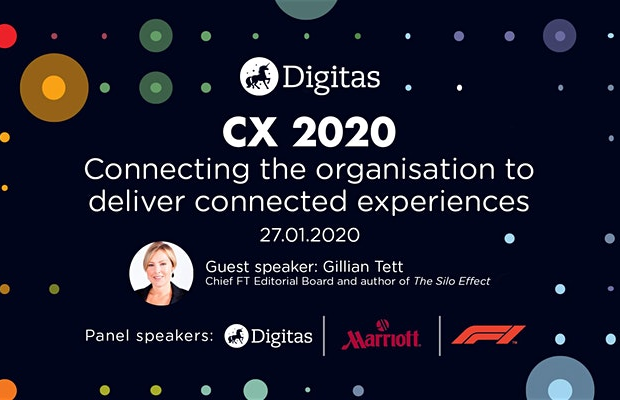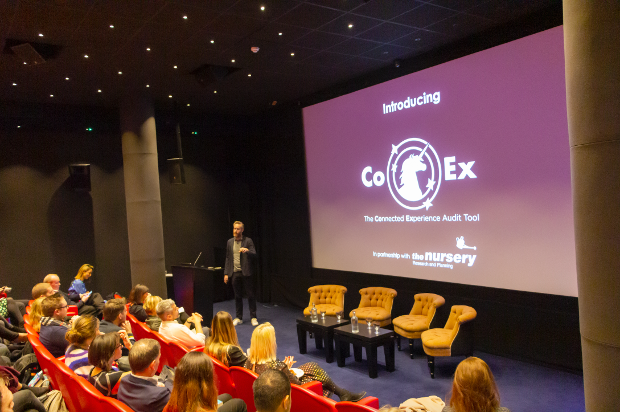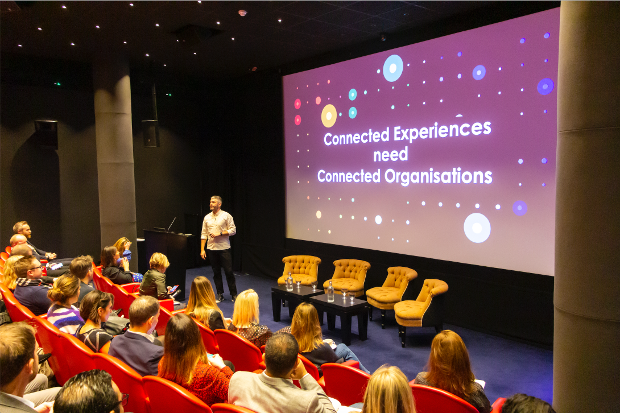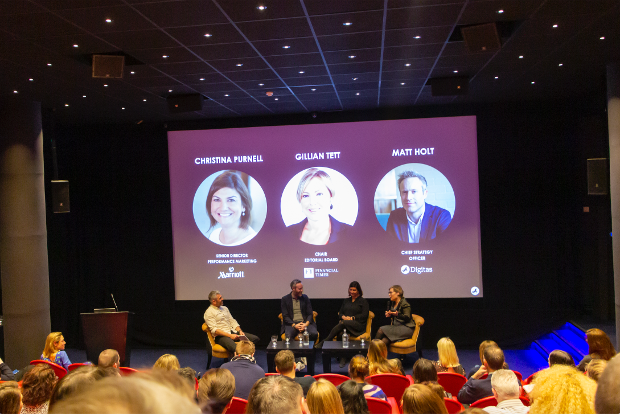
Digitas CX2020: Connecting the Organisation to Deliver Connected Experiences

Earlier this week Matt Holt, Digitas UK Chief Strategy Officer, welcomed a bumper audience to the CX2020 at London’s Soho Hotel, kicking off proceedings by outlining ‘The Experience Problem’.
Recent research from Digitas UK showed that nine out of every 10 people in the UK agreed that we are more disconnected as a society than ever before (November 2019). To set the scene for the experience problem, Matt described a context that, despite all our interlocked customer systems, has seen the world become “divided by screens, borders, politics, and religion.”
That disconnection is also seen in businesses as they struggle with silos, meaning the customer experience is often disconnected. The problem is that people are demanding connected experiences like never before. However, according to the same Digitas research, 81% of them agree that brands are not making meaningful connections.
To address these challenges, Digitas UK has launched a new experience model taking into account three pillars (“total”, “brand” and “experience”) that includes a total of nine dimensions that contribute to a connected customer experience for customers.
This service is driven, in part, by Digitas UK’s Connected Experience (CoEx) Audit Tool, delivered in partnership with research and planning experts The Nursery. Early application of the tool has focused on the hospitality and utility industries. Matt then handed over to Valeria Corna, strategy director within Digitas’ experience consultancy team, to talk through the results of this research and to show the CoEx tool in action.

A new experience model
Valeria revealed how the insights highlighted that the primary drivers of customer satisfaction when it comes to experience are the same in the hospitality sector as in the energy category – emotion, coherence, ease, and usefulness.
She outlined how emotion – “the capability of a brand to trigger positive feeling in its customers at every interaction” – involves considering customers’ emotional responses along a spectrum including: your employees, your digital properties and, finally, intelligent agents.
In terms of maximising the impact of your own people, Corna cited Zappos, the online retailer and how they have set a mission is to wow customers through great customer service, but are letting their employees define what wow means and how to achieve it.
When it comes to digital properties, she emphasised that companies have to plan online customer journeys very closely with a particular focus on turning negative moments into positive ones. As an example she cited a 20th Century Fox website error page that provided a way forward rather than simply shutting down the experience.
Valeria then described how intelligent agents, whether being used in shops to welcome people or in homes to encourage patients to take their medicine, are becoming increasingly anthropomorphic in an attempt to establish emotional connections with their users. But there is more, they are also becoming better equipped at detecting our emotions offering a huge amount of relevant data brands can use to respond to their customers in a unique, personalised and contextually relevant way.
Turning to the importance of providing coherence and consistently delivering on a brand’s promise, Valeria focused in on the hospitality industry. She revealed that the worst performer in this specific dimension, amongst the brands researched, was Airbnb. The company’s brand promise, “belonging anywhere”, is bold and distinctive but not backed up by an equally relevant experience, according to the customers surveyed. Airbnb performance resulted below those of other hotel brands along a number of experience dimensions including usefulness, ease, and empathy. “Clearly, handing over control of a guest’s say comes with a price.”
There is another reason however that could explain why Airbnb’s experience performance is worse than that of hotel brands surveyed: hotel brands have now adapted very well to the changes and disruptions that Airbnb has brought to the industry. She cited Airbnb experiences as an example and showed how other hotel brands, like Belmond, launched a similar offering whilst connecting it to their brand heritage.
The presentation also shed light on which stages of the guest journey have a biggest impact on satisfaction showing that the experience offered in-room is the biggest satisfaction driver, but also the stage of the guest journey where many hotel brands are performing below expectations.
So, hotels should definitely keep adapting to the relevant changes that disruptors like Airbnb are bringing to the industry, but they should also re-focus on their core assets and competences starting from the experience they offer in-room.

Connected experiences need connected organisations
Dave Lowe, strategy partner at Digitas UK, followed on with a talk about the importance of connecting organisations to deliver these connected experiences. Using the analogy of the cinema and filmmaking, he said: “I’m not talking about what’s on screen, what the audience sees, but what going on behind the camera, what the audience doesn’t see.”
Dave focused on the need for organisations to solve issues behind the scenes in order to improve the experiences delivered to customers. He concentrated on issues in four overlapping areas Data; Platforms & Tools; Knowledge & Ways of Working; and Organisation & Culture. These are all areas of your business that your customers care about, they just don’t know it!
Data: Themes outlined included the profusion of data created across the customer journey, and the skill involved in “identifying what you’ll collect, analyse and apply to enhance the experience.” Data can even be used to provide empathy and understand customer pain points before they become bigger issues, for example using hearing aid data to understand issues with adoption”. Dave also cited a banking client of the agency where NLP and machine learning was applied to understand the content of 10,000+ voice and text conversations between customers and contact centre agents. The insights gleaned from this were applied to prioritise self-help content on the company’s website, which was ultimately useful for the customer and delivered savings for the organisation through reducing call centre enquiries.
Platforms & Tools: Platforms and tools can provide obvious utility to make life quicker and easier for both customers and the organisation providing the service. This could be a case of providing, via an app, the ability to submit a meter reading through a camera/screenshot facility. More surprising is the role that technology infrastructure can enhance positive emotions within an experience.

Knowledge & Ways of Working: Dave outlined how delivering experiences across channels requires people in a greater number of teams to work together, consider the example of launching a click and collect service in a department store – not only does the onsite experience need to be slick, the in-store team have to be trained to be aware of the steps in the process that are completed in store. Furthermore, ways of working can improve the effectiveness of what the customers see and hear, particularly where alignment amongst diverse stakeholders is important. It’s possible to drive this by putting a greater emphasis on co-developing and reviewing a plan of action with the resulting priorities providing a clearer experience for customers, a better use of limited resources and less infighting!
Organisation & Culture: Coherence is enabled by organisation and cultural factors. For instance, a brand’s ability to speak in the same voice across channels requires “different teams to be involved in shaping and delivering the experience, and that doesn’t happen by accident.” In terms of differentiation versus the competition, Dave explained, “culture can be critical, organisations known to innovate have built a culture that rewards collaboration, failing fast and learning from mistakes. This is not quick or easy to achieve and depends upon leadership demonstrating and acknowledging the desired behaviours”.
Dave’s points about organisational challenges that must be surmounted, and the idea that “on the other side of any screen, there’s a customer who wants a connected experience” segued neatly into the keynote speech from Gillian Tett, the Chair of the FT Editorial Board and author of The Silo Effect.
Breaking down silos
Gillian’s talk, drawing on her training in anthropology, 20 years as a journalist, and the experience of writing The Silo Effect, looked at Silos and silences, the 21st century paradox.
The paradox exists, she said, because “we think our phones connect us more than at any other time, but then we know that we live in a fragmented, disconnected, world.”
Opening with the story of how Sony failed to capitalise on the success of its Walkman to own digital music in the 21st century, Gillian described that this was down to the fragmentation and silos that existed within the Japanese corporation: “Sony achieved success by creating teams of brilliant experts, each of these teams thought they were incredibly clever and successful but in no shape or form did they collaborate. In fact, they competed for glory within the company.”
Gillian built her argument by describing how the majority of big scandals and disasters in both the corporate and government spheres – the financial crash of 2008, the success of the 9/11 terrorists – were “not because people were evil, or guilty, but because they’re haunted by silos… these make bright people stupid, and make organisations not just miss big opportunities but face terrible risks and dangers.”
What can we learn from Facebook?
Silos are unavoidable because humans are “hardwired to classify the world and put it into buckets,” said Gillian. Therefore the task is to manage them, rather than attempt to eradicate their presence completely.
In her research Gillian studied Facebook, which she explained, “is interesting because it’s good at creating a consistent culture inside, bringing people in, putting them in teams, and making sure teams keep collaborating.” It achieves this by rotating people internally, creating relationships across departments with its Bootcamp training that each new employee receives, and by running regular big forums involving people in different teams.
Lessons in managing silos can also be learned from Cleveland Clinic in the US – which reinvented its whole structure by creating new silos “based around consumers and how they see the world, then working backwards.” This put the emphasis on new functions based around body parts – such as the Brain Institute and the Heart Institute as opposed to those based on the needs and training of their clinicians.
Removing the silos around data can also have a positive impact, as shown by firefighting in New York. City Hall there moved from predicting fire outbreaks based on fire department data alone to pooling lots of other data that indicated neglect of property and risk of fire – vermin infestations, mortgage defaults etc. – from across departments. The result? A five-fold rise in the accuracy of predicting fire outbreaks with no extra cost.
Tett concluded with a checklist on how organisations can best break down silos:
- First, notice that silos exist
- Re-imagine taxonomy
- Look at social silences
- Keep boundaries flexible
- Give multiple affiliations to groups
- Use technology (carefully)
- And think about silos… again
Panel
Following the keynote, the speakers then assembled for a panel discussion. The line-up featured Christina Purnell, Senior Director Performance Marketing at Marriott International; Gillian Tett, Author of The Silo Effect; Matt Holt CSO Digitas; and was facilitated by Dave Lowe, and focused on delivering better experiences to customers.
Gillian Tett: “Often the things we focus on as suppliers of services are our own sense of ordering the world. We often lose track of what consumers want, and the way they think. We have to spend time immersing ourselves as anthropologists, as listeners, and understand what consumers want. Take Airbnb – is it actually providing what consumers want? Are hotels? Finding the answers requires listening and taking away our preconceptions.”
Matt Holt: “We place so much emphasis on the importance of skillsets. There’s generalism and specialism in the industry but often we go into a channel too soon, rather than understanding the customer and the research. A shift needs to take place if we’re going to improve experiences, by taking a step back. Understand the problem you’re trying to solve and then the channels tend to work themselves out.”

Christina Purnell: “At Marriott, we have a great website and state-of-the-art app, but if we don’t follow through on deliver on service at the property level, then we’re dead in the water. Sitting at the same table as the head of Rooms Operations & Services at the same time we are discussing media and platforms really helps.”
Gillian Tett: “We need to think ourselves into minds of others, spend a week or a day in another company, talk to someone in a different industry, read yourself online into someone else’s business. For a week put 20 people in your social media feed that are completely different people from your worldview. Then look back on yourself.”
Christina Purnell: “Going out and looking at things as the consumer sounds so simple, but bringing people in who never would have thought in the same way, and having the right people across all disciplines at the table from the start, is so important.”
Gillian Tett: “There’s now so much emphasis on being ultra efficient, it’s hard to defend the idea of having some slack, in order to roam and understand the issue as an outsider. We all need some slack to explore, if we don’t have this then we end up like Sony.”
Dave Lowe: “I like the idea of slack, but use it to get into the minds of your customers, and in your organisations by talking to people from different departments.”
#DigitasCX2020 conclusions
Following the panel session, Dave Lowe concluded the session with two main points:
Experience matters. That’s why Digitas has developed the Connected Experience framework, but we also need to think about organisation. What’s going on, and how people work, because changes are needed across data, platforms and tools, and knowledge and ways of working to enable a connected experience.
Experience Consulting from Digitas has been set up to help organisations and brands to architect their experience ambition, and enable the change to bring this to life for their customers. When considering this, think about what’s going on on the other side of the camera the next time you are at the cinema, as well as what’s projected on screen.













